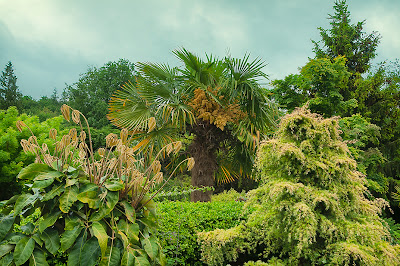 |
| Trillium chloropetalum 'Volcano' closeup view |
 |
| Trillium chloropetalum 'Volcano' clump blooming in my garden now |
Trilliums have become one of my favorite plants and I want to tell you about one of the best of this great group of plants. Trillium chloropetalum is one of the trilliums native to the west coast of the U.S., although I am not sure that it grows in the woods near us. I have read that it is found more commonly in southwestern Oregon and northern California, but I am not an expert on where it is found in the wild. I have purchased and have seen over the years a number of plants labeled as Trillium chloropetalum, but in my humble opinion, two forms of this plant are so far above the others that I would not bother with any but those two forms. The first of those forms is the one today's blog is about--Trillium chloropetalum 'Volcano', and the other form I will blog about tomorrow (not to keep you in suspense, but the other is one I call the Duane West Strain, named after the former manager of Heronswood).
Volcano is a form I got from those plants persons extraordinaire, Ernie and Marietta O'Byrne, who have a nursery outside of Eugene, Oregon called
Northwest Garden Nursery. The O'Byrnes now specialize in hellebores (I think they have the best hellebores on the market), and I do not know if they still sell any other kind of plant. I got my Volcano from them a number of years ago.
According to Ernie O'Byrne, Volcano was a trillium that was selected in New Zealand for its good form and flower color. As you can see from the pictures above, the flowers are a good rich red and they are very large. The plant is also a vigorous grower, and the leaves have good markings on them.
Some years ago, I have been told, someone succeeded in tissue culturing Volcano, but the success rate of the process was not high, and so the nursery involved in the effort gave it up. (Tissue culture, for those who don't know, is a method of growing plants from a few cells in a laboratory). This means that Volcano is only available now as divisions of individual plants and that is why it is so hard to come by. I have not gotten any seed set on my plants of Volcano either, so I have not had any seedlings of it, although I have had lots of seedlings of other trilliums, including other forms of chloropetalum, in my garden.
The one bright spot in all this is that Volcano is a vigorous plant and divides easily. Last year in early spring I divided the plant you see in the pictures above, and I got more than 25 divisions from that one plant, even though I left the biggest part of the plant undivided. That is why you see such a big plant in the pictures. You will be glad to know that all of those divisions are now also blooming. I am going to be giving a number of those divisions to Kelly and Sue from
Far Reaches Farm, so hopefully in future this great trillium will be more widely available.
For those who want to know, I divide my trilliums in early spring before there is any substantial growth on them. This practice has worked quite well for me, although I have read that others divide their trilliums after they have bloomed and gone to seed. I have never tried that so do not know how it compares to my method.
As for growing these trilliums, they like what all shade plants seem to like--good humus enriched soil, well drained but also moist (almost an oxymoron), not too shady, but not too sunny, and not much competition from tree roots. I have found that my trilliums decline in too much shade and with too much competition from other plants. These trilliums are west coast natives which means that they are adapted to our rainfall patterns here. That means that they don't really need any extra water in the summer--they just basically go dormant in the dry summer months.






































